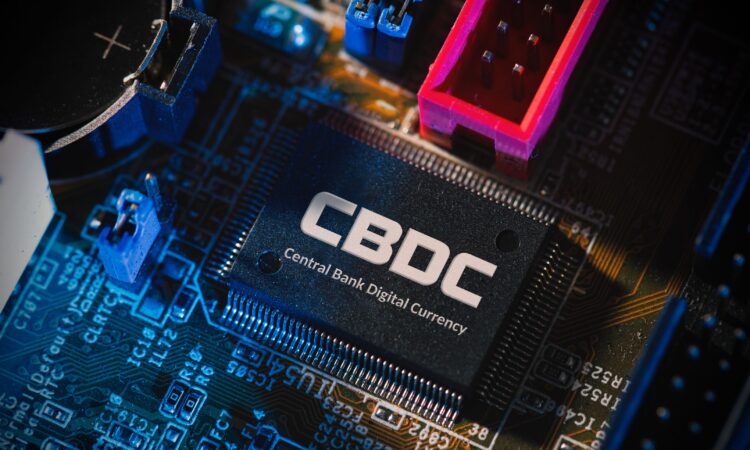
By Atul Bhatia, CFA
Key points
-
Electronic payments are on the rise as cash usage declines across the
globe, leading an increasing number of governments to think about
launching digital versions of their currencies. -
Central bank digital currencies, or CBDCs, in theory offer faster and
cheaper payments, allow people currently outside the traditional
banking system access to financial infrastructure, and could reduce
settlement risk and delays on international trade. -
Despite the hype around CBDCs, we see a host of security, privacy, and
governance concerns that we believe outweigh the theoretical gains on
efficiency, and we think it would be quite challenging to line up the
necessary political support for an aggressive push toward a digital
dollar. -
We think the Federal Reserve will continue to emphasize incremental
technology improvements versus a risky push to transform the payments
infrastructure. -
Bottom line: Commercial bank accounts and physical cash are likely to
remain at the center of U.S. financial architecture for the
foreseeable future.
Cash may be king, but the crown seems to have lost some of its luster of
late. Survey data shows consumers across the world increasingly prefer
electronic payment over currency, with more than 70 percent of respondents
from countries as varied as Sweden and South Korea wanting to go cashless.
At the same time, producing and distributing currency – as well as fighting
counterfeit notes – is an expensive and difficult process. The solution, it
would seem, is obvious: have central banks distribute currency in
electronic format, an idea known as a central bank digital currency or
CBDC.
CBDC is a global phenomenon, with dozens of countries studying the idea
and a handful already implementing some version of a CBDC. Given the
global prominence of U.S. currency, we focus our discussion on the
potential for a digital dollar, and conclude with a brief discussion of
China’s experience as one of the leaders in rolling out digital currency.
Showing its age? Younger people use cash less often
Percentage of payments made using various methods, by age cohort
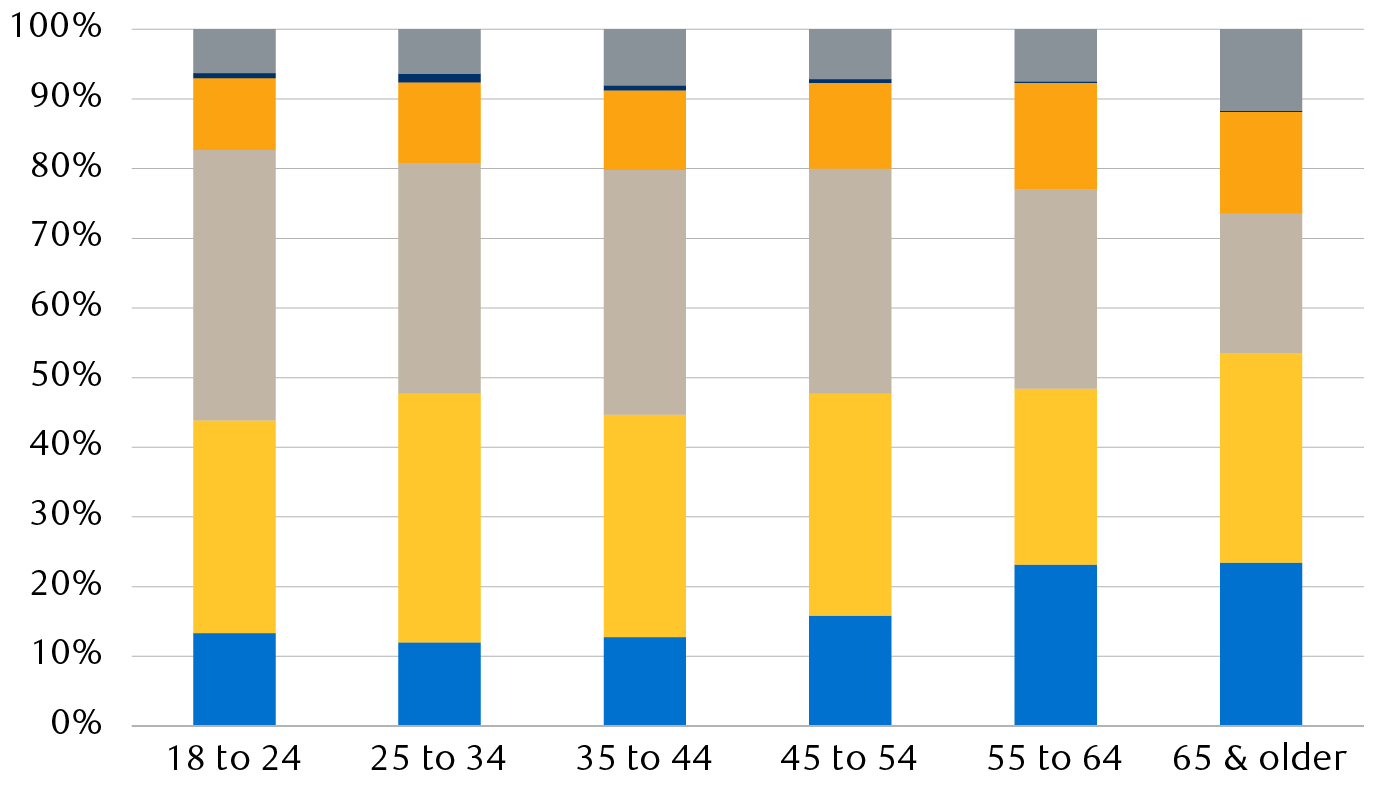
Column chart showing how payments system usage varies with age and reflects an increased use of cash in older cohorts, with those 55 and older using cash 20% of the time. Individuals under 45 use cash about half as much as those over 55, with the difference being increased use of credit and debt by younger users.
-
Cash
-
Credit
-
Debit
-
ACH
-
Mobile Payment App
-
Other
Source – Federal Reserve Bank of San Francisco; ACH = Automated
Clearing House
Digital currency label breeds confusion
As with many financial innovations, we think rhetoric has outstripped
precision, so there are some differences in what people mean when they
talk about central bank digital currencies. For us, a true CBDC is a
system where individuals hold currency directly at a central bank, in
electronic format, with no means of converting their holdings into
physical currency.
Although digital, CBDCs are not cryptocurrencies. One hallmark of a
cryptocurrency is that the supply of money is not controlled by an
institution. Bitcoin, for instance, is created and paid out as a reward to
so-called miners, or the users who perform the background computational
work to keep the system going. CBDC, on the other hand, remains fiat
money, created or destroyed by a central bank as part of its monetary
policy decision-making. Some of the CBDCs being evaluated by central banks
rely on the digital architecture of cryptocurrencies, such as blockchain
verification, but that’s a distraction, in our view. At its core, a
digital dollar is still a dollar, and the number in circulation is set by
the Federal Reserve, not a formula.
CBDCs’ place in the currency landscape
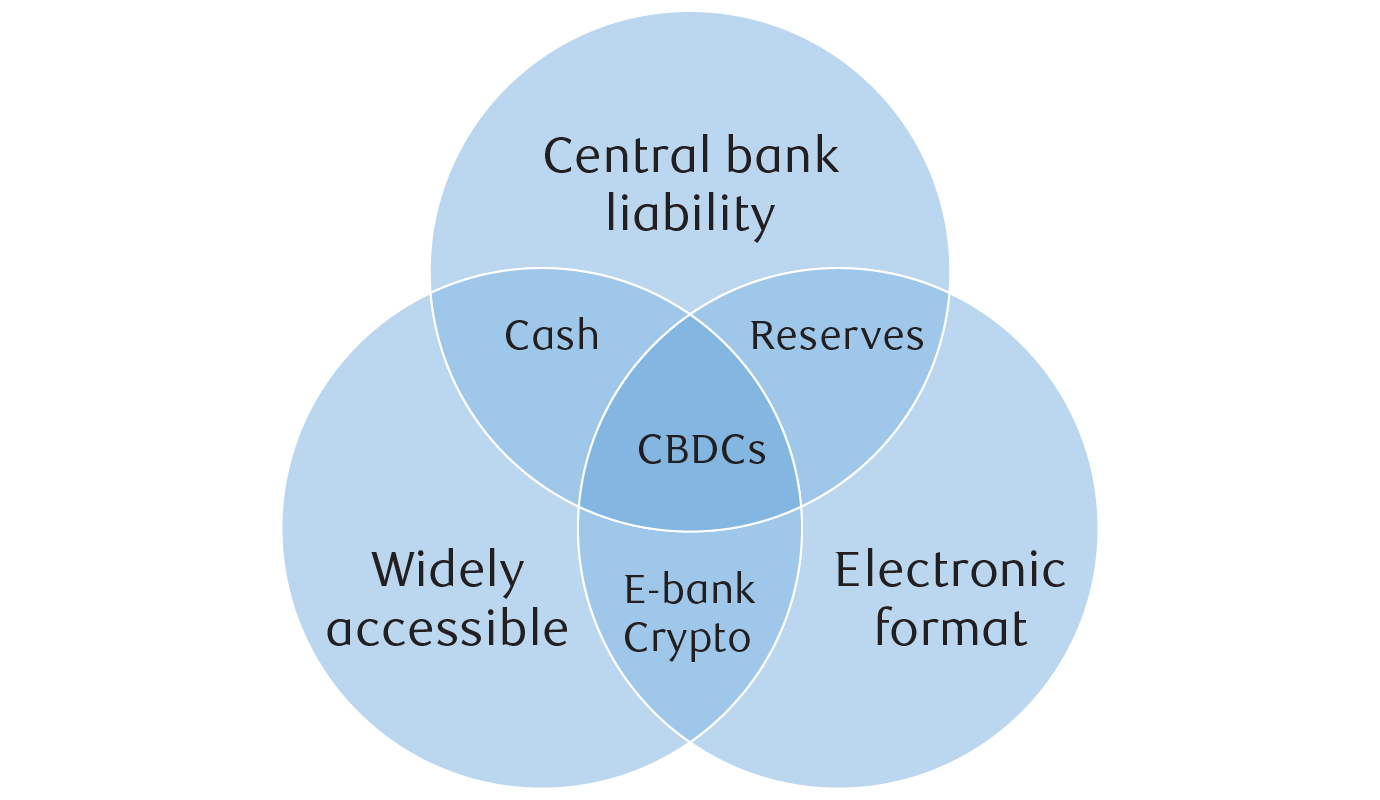
This is a Venn diagram showing the overlap between three characteristics of different payment types: central bank liability, electronic format, and widely accessible. CBDCs are at the intersection of all three, cash is in the overlap between widely accessible and central bank liability, reserves are in the overlap between central bank liability and electronic, and crypto and e-banking are at the overlap of electronic and widely accessible.
Source – RBC Wealth Management
In fact, despite the emphasis on the digital format, we believe the core
difference between a digital currency system and a physical one is how
records of ownership are maintained.
With physical dollars, ownership records are diffuse. The cash that an
individual has on deposit with a bank is largely known only to the bank
and the depositor. Funds can be transferred completely anonymously, via
cash, and even when transferred electronically, records of the movement
will be separated: the payer’s bank, for instance, will know which account
to debit, but it won’t know any information about the recipient. The
receiving bank will credit its customer yet knows nothing about the payer.
This system is gloriously inefficient, with a single transaction easily
requiring four separate institutions to update records and possibly taking
days to make the transfer final, but it has also functioned effectively
for centuries.
In the case of a digital dollar, efficiency is the watchword. Ownership
records are fully electronic and consolidated, making movements between
accounts simple and instantaneous. In practice, individuals and businesses
would likely have accounts directly at the Fed, and buying groceries, for
instance, would simply involve a customer moving CBDC from its Fed account
to the grocer’s. Since both accounts are held at the same institution, the
central bank can instantly and freely transfer the funds, eliminating the
delays inherent in our current, dispersed banking system.
This type of digitization is not new. The U.S. essentially went through
this process in the 1980s, when Treasury bond ownership went from being
physical securities to so-called book-entry format. Conceptually, that
move was identical to what’s being contemplated here: replacing a physical
asset – paper bonds with attached coupons – with a central database recording
ownership. Book entry made transfers simple and coupon payments routine,
generating massive efficiency in the Treasury bond market. The difference
between CBDCs and book entry bonds is one of degree, not kind.
McMoney – fast and cheap
Broadly speaking, we see two main benefits to countries that choose to
implement a CBDC.
First, it would reduce costs and increase access to payment services. In
the U.S., for instance, roughly five percent of the U.S. population does
not have a bank account and most small businesses pay between two percent
and five percent of revenues for payment processing, mainly credit card
fees. A CBDC would eliminate those costs and bring the entire population
into the banking system, creating savings and efficiencies that would be
felt positively, even in an economy the size of the United States’. For
countries with larger unbanked populations or higher payment fees, the
potential gains would be even more important.
Second, it would reduce transaction processing times and so-called float
risk, as suppliers wait for payments to clear. This is mainly an issue for
larger corporate transactions and international trade, but the ability to
create immediate transfers in a closed financial system can mitigate
certain types of fraud risk and can greatly reduce lost interest income.
There are other potential benefits that CBDCs can create by reducing
counterfeiting, cutting production and distribution costs, and potentially
helping policy implementation, but we think those are of secondary
importance. The economic case for a CBDC, we believe, begins and ends with
the efficiency of reducing financial friction costs across the economy.
Why a CBDC won’t be coming to a Federal Reserve near you anytime soon
Economists in general like efficiency, but the flipside is that efficient
systems lack the redundancy that make for stability. We think having a
single point of failure for dollar payments in a world that uses the
greenback for all manner of trade is, in a nutshell, a terrible idea. In
one move, we think the U.S. would create an unparalleled target for
hackers and thieves, not to mention terrorists or geopolitical rivals.
Even a cursory look at the history of electronic security shows the risks
of centralizing data and wealth.
Existing levels of cybercrime highlight risks
Share of companies reporting cyberfraud events in previous two years, by
sector
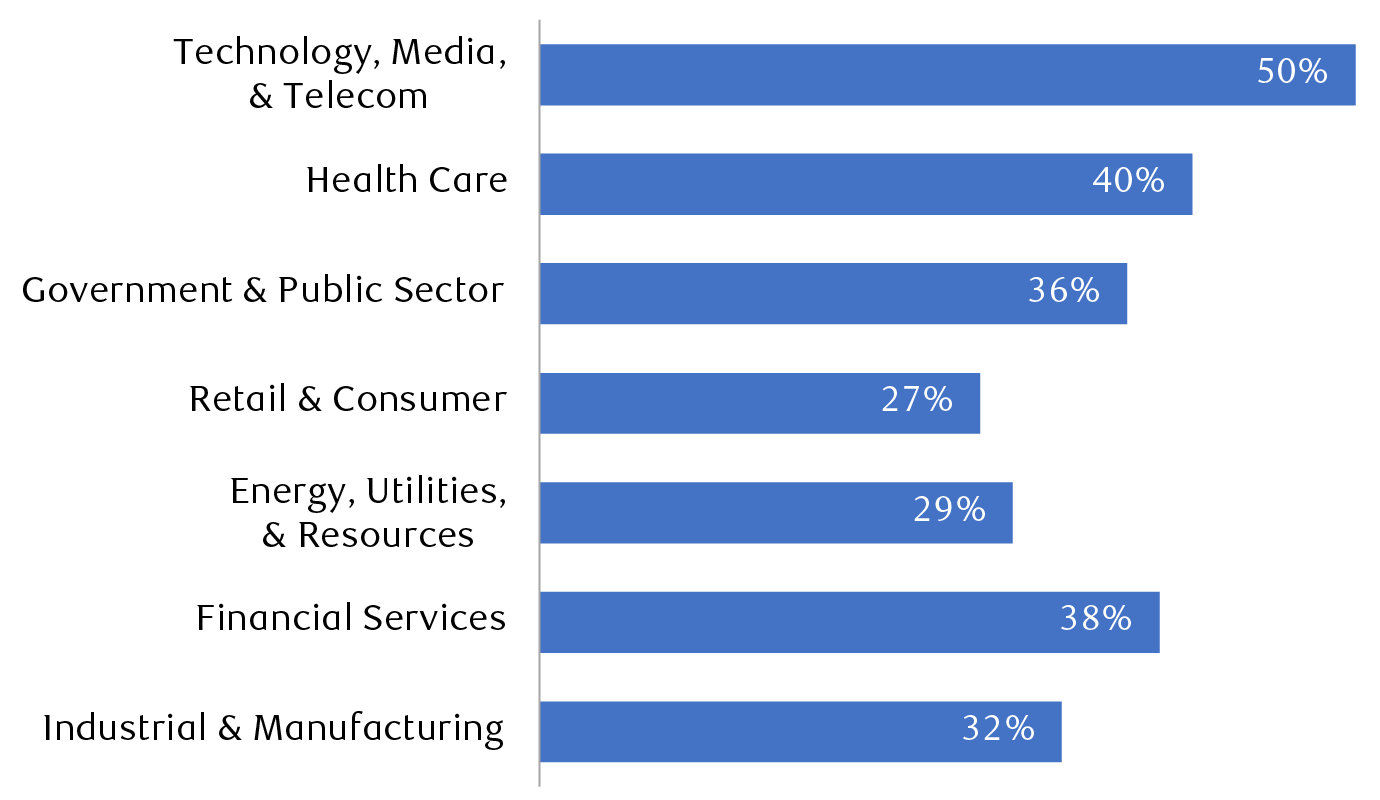
Bar chart showing the percentage of companies reporting cyber fraud incidents in the previous 24 months. The chart shows values ranging from 27% for Retail to 50% for Technology, Media, & Telecom companies. Additional companies shown: Health Care: 40%; Government & Public Sector: 36%; Energy, Utilities, & Resource: 29%, Financial Services: 38%; and Industrial & Manufacturing: 32%.
Source – PwC Global Economic Crime and Fraud Survey 2022
Putting aside potential bad actors, what about a software update that goes
wrong? The U.S. has seen nationwide flight departures canceled because a
contractor accidentally deleted the wrong files in a critical Federal
Aviation Administration system. That was bad, but a world where dollarized
economic activity cannot take place for hours or days or even minutes
would be catastrophic.
The Fed already operates mission-critical payments systems, but these
generally offer connections only to depository institutions or regional
Federal Reserve banks. Trying to secure a system offering hundreds of
millions of access points to trillions of dollars on a 24/7 basis is a
Herculean task, and we believe current technology and practices are
insufficient to truly protect a CBDC environment.
Outside of security, there are also privacy concerns with centralizing
sensitive financial information and making it available to the government.
In the U.S., federal officials already have broad access to individual
financial data via subpoena powers, but combining all financial
information in one spot is a step-change higher in potential informational
abuses.
There are also concerns the government would be able to interfere with
certain transactions. Take, for instance, the U.S. states where marijuana
is now legal. Many of these businesses already struggle to find banking
services, but that fight is nothing compared to the potential impact of
being shut out by the Fed in a world where a CBDC is the only alternative.
A single decision to cut off marijuana spending would reduce those
businesses – deemed legal by the states where they operate – to bankruptcy or
the barter system.
Even with privacy guardrails, we believe the potential powers a CBDC would
give to the Fed – which is already a massively powerful institution – would
almost inevitably lead to politicization of the central bank. We shudder
to think of the U.S. Senate confirmation hearings for a Fed chair nominee
in a world where that person could exert practical control over the
payments system, and we believe those political considerations would
quickly override the monetary policy credentials for future nominees.
No, really, not anytime soon
On balance, our view is that it’s difficult to make a strong theoretical
case for moving to a CBDC infrastructure. The efficiency benefits are real
and meaningful, but they simply cannot justify creating a single point of
failure in critical payments infrastructure.
In practical terms, we see an even steeper climb for the digital dollar.
Historically, the U.S. has never been an early adopter of financial
innovation. It was one of the last countries to implement chip credit
cards, and the U.S. remains the largest user of paper checks in the world.
Over five percent of cashless payments in the U.S. still take place by
signing little chits of paper; it’s difficult to reconcile that with the
imminent arrival of digital currency wallets.
We also see significant pushback from existing players in the financial
infrastructure. Last year, the two largest U.S. credit card networks
reported over $50 billion in revenues – which would be under immediate and
severe threat if a CBDC offered a free alternative.
The broader banking system would not be immune from the impact of a CBDC.
At a minimum, we see a digital dollar raising funding costs for banks, as
zero-interest depositors would have no need to stay in the cumbersome
commercial banking system when the Fed offered an instant and free
alternative. If the Fed were to offer interest on deposits – broadening the
digital currency from a simple cash substitute to a digital money
supply – then the risk to banks increases exponentially. At that point, the
Fed would be a true competitor to deposit-taking and loan-making
institutions in their core businesses.
In congressional testimony on CBDCs in 2022, CEOs of large banks were
ambivalent-to-negative, mainly couching criticism on practical grounds.
Given the stakes to the well-heeled and politically astute financial
players, we would expect much more significant pushback if a digital
dollar ever moved closer to reality.
Geography heavily influences financial professionals’ support for a CBDC
Percentage of respondents in favour of launching a CBDC
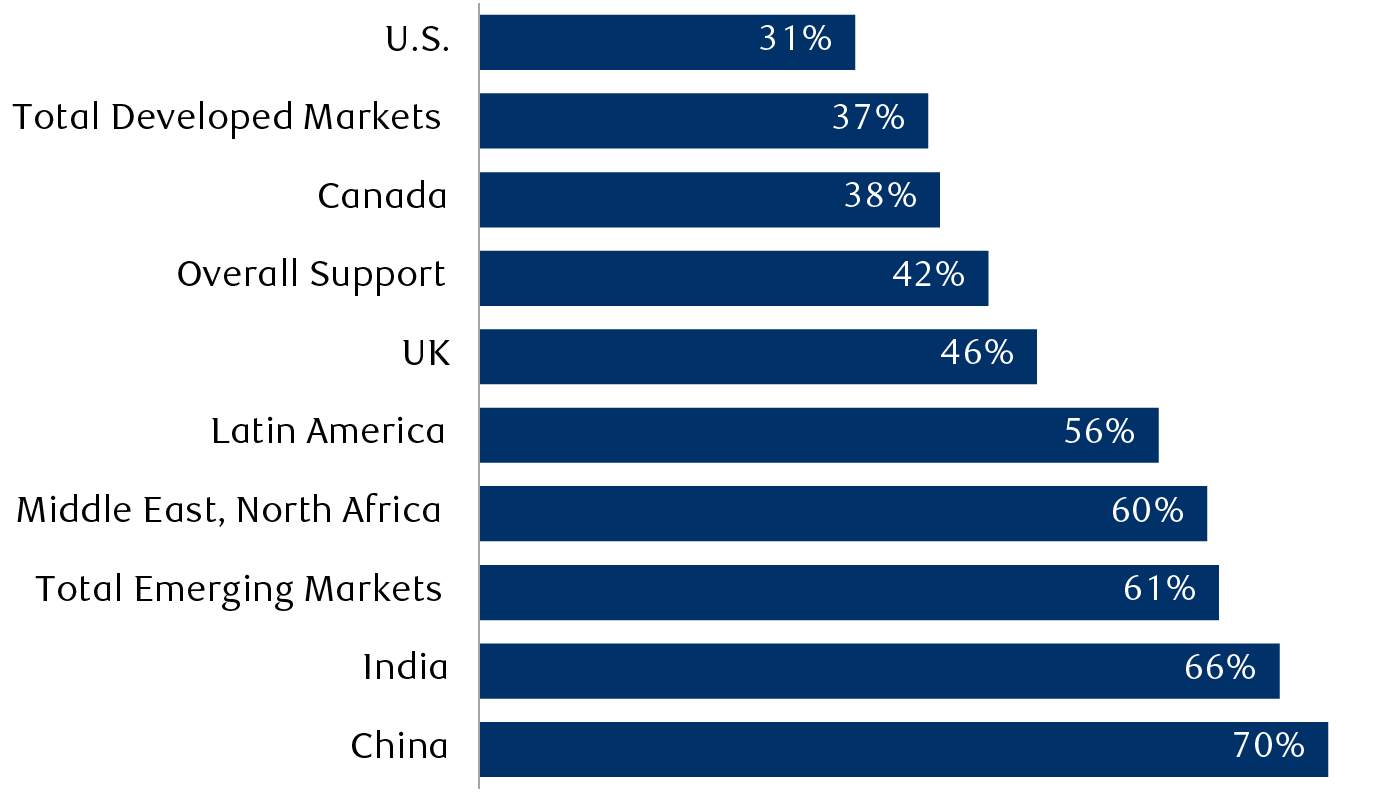
Bar chart showing Chartered Financial Analysts’ support for CBDC based on geography. CFA charterholders in China have the highest level of support at 70%, while in the U.S. only 31% favour launching CBDC. Additional geographies shown: Total Developed Markets: 37%; Canada: 38%; Overall Support: 42%; UK: 46%; Latin America: 56%; Middle East, North Africa: 60%; Total Emerging Markets: 61%; and India: 66%.
Source – CFA Institute; respondents were CFA charterholders
The bottom line is that between privacy, security, and lobbying, we see a
CBDC as a tough sell to the U.S. Congress.
Incremental, not transformative, technology
Rather than fully transition to a CBDC, we expect the Fed and most other
central banks to take a more measured approach, closely integrating
technology to achieve efficiency but operating in parallel with existing
payment structures.
Take, for instance, FedNow, a new real-time payments system created by the
Federal Reserve. Like a CBDC, the system allows immediate, electronic
settlement, but, critically, it operates between depository institutions.
The limited scope reduces security concerns, while competitive forces
should eventually bring FedNow’s time and cost savings to individual
customers. This private-public hybrid approach, in our view, is both
better and more likely to occur.
The case for a CBDC is also weakened by the rise of large, global
commercial banks. Many of the benefits of centralizing payments are
already occurring, as trade between multinational companies is often
settled at one of the dozens of truly global banks. These banking services
are not free, but they have the potential to deliver many of the
efficiencies provided by a CBDC without the baggage of centralized
control.
We think the Fed is likely to continue studying a digital dollar and
running pilot programs. It would be unwise not to since the dollar’s
preeminent role in trade may someday require a digital currency. We
believe the Fed may even launch something it calls a digital dollar, even
if in practice it’s just a check-the-box exercise to show the U.S. also
has the latest shiny new toy.
Central banks move forward, slowly, with CBDCs
Number of CBDC projects by stage of development
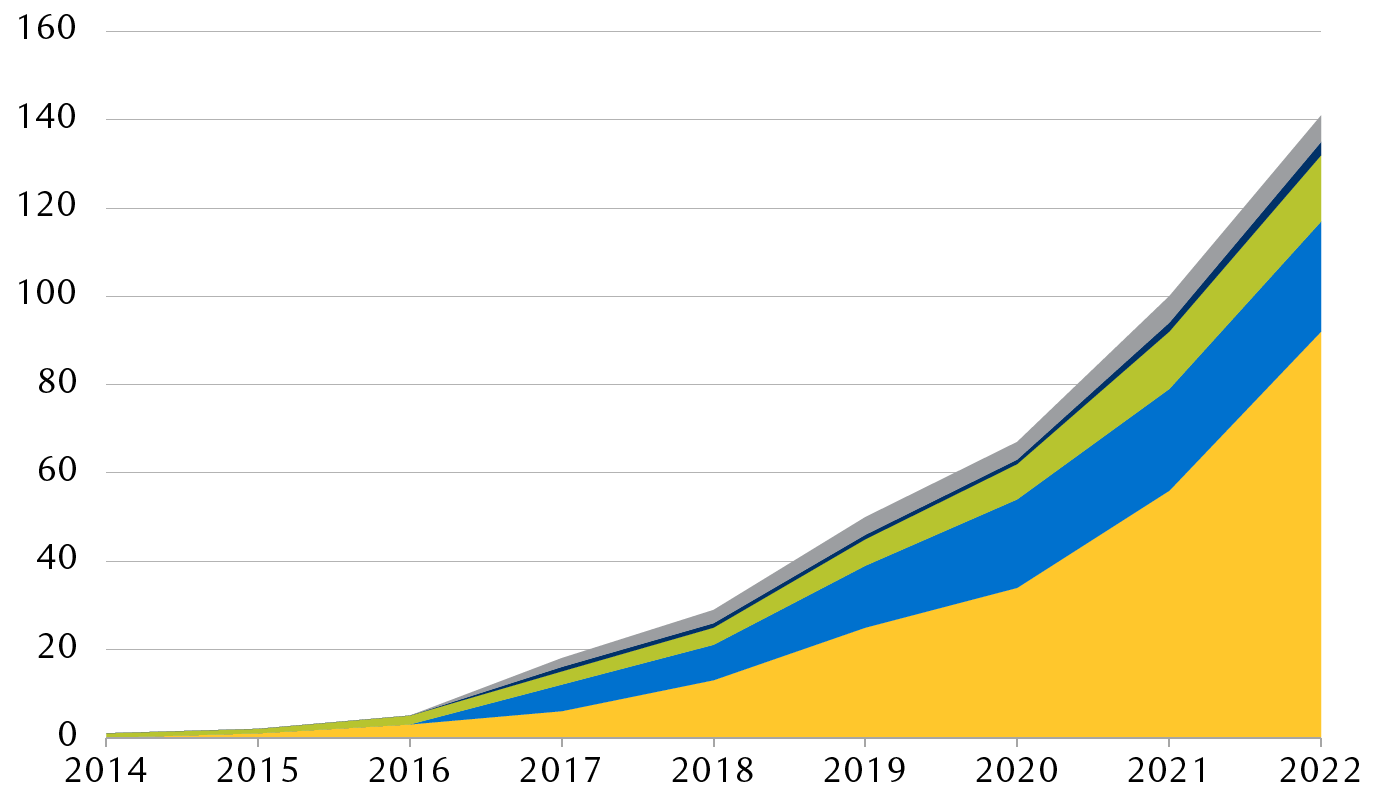
Area chart tracking the evolution of central bank actions on CBDC. In 2015, there were only two central banks active in CBDC, but by 2022, over 135 CBDC projects were active, with 92 of these being in the research phase, with the balance in proof of concept, pilot, or already launched.
-
Research
-
Proof of concept
-
Pilot
-
Launched
-
Canceled
Source – CBDCTracker.org, International Monetary Fund, RBC Wealth
Management
Realistically, however, we see physical currency and individual deposit
accounts at commercial banks at the center of the U.S. system for the
foreseeable future.
China in the lead
Unlike the U.S., China has been a leader in the digital currency field,
rolling out the digital yuan, also known as e-CNY, and actively
encouraging its use. The Chinese have implemented several interesting
twists on the CBDC concept. First, the e-CNY pays no interest, making it
much more of a pure cash substitute than other CBDCs under discussion that
allow for interest payments. In addition, the use of e-CNY is voluntary
and intermediated through large banks. These differences seek to reduce
the impact of the digital yuan on the traditional banking system, but they
also can reduce many of the potential efficiencies.
Uptake for e-CNY has been limited, with officials reporting less than 0.2
percent of cash has shifted into the digital format. One of the main
problems for e-CNY, in our view, is the prevalence, quality, and
integration of the existing digital payment platforms. Private sector
mobile payments in China go back nearly 20 years, and the two major
players control 90 percent of the country’s digital payments market. The
e-CNY has been growing, but the private-sector alternatives are already
low-cost and embedded in the user’s digital life. One advantage of e-CNY
is its ability to function when a user is offline, a key differentiator in
remote areas or during natural disasters, but one that has yet to
translate into broad usage of the digital yuan.
In essence, China has so far been taking an incremental approach, similar
to what we see the Fed doing. The difference is that the Chinese are
relying on the structure of the e-CNY to limit its potential as a
surrogate for the broader banking system, while we see the Fed eschewing
the concept of a digital dollar, at least for the near future.
China continues to push forward on the use of CBDCs for international
trade. The most recent step has been the launch of mBridge, a fully
digital trade settlement platform involving China, Thailand, the United
Arab Emirates, and Hong Kong. The infrastructure is important, but we see
limited uptake until the more widely held currencies such as the euro or
the U.S. dollar are in the system. The benefits of CBDC settlement are not
going to be sufficient, in our view, to shift investor and corporate
preferences around currency exposure.
Small steps on a long road
Central bank digital currencies, in some form, are likely to be adopted by
an increasing number of countries. Nations with a high percentage of
electronic payments, or a relatively concentrated and small banking
system, may find it easier to introduce some form of a CBDC. In time,
these countries or others may realize the efficiency potential of central
bank digital currency in a secure format. For now, however, we believe
CBDCs should be viewed as an adjunct to existing payment and banking
systems. We see evolution, not revolution.



